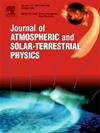中国大陆基于ERA5 PWV和FY-4A PWV的PWV融合研究
IF 1.9
4区 地球科学
Q3 GEOCHEMISTRY & GEOPHYSICS
Journal of Atmospheric and Solar-Terrestrial Physics
Pub Date : 2025-04-24
DOI:10.1016/j.jastp.2025.106526
引用次数: 0
摘要
可降水量(PWV)的高精度和高时空分辨率是气象研究、灾害性天气预报和预警系统以及长期气候变化趋势分析的基础支撑。FY-4A PWV以其较高的观测精度和优越的空间分辨率在PWV研究中得到了广泛的应用。然而,由于天气和云量的影响,FY-4A PWV中有许多缺失值。ERA5 PWV具有时间分辨率高、数据完整、更新快、参数多等优点,但其空间分辨率在0.25°× 0.25°时相对较低。因此,本研究的重点是整合多个数据集的优势,获得具有优越时空分辨率和完整性的高精度PWV数据。本研究以中国大陆为研究区,采用三次卷积插值方法将ERA5 PWV插值到与FY-4A PWV相同的空间分辨率(4km × 4km),并利用插值后的ERA5 PWV补全FY-4A PWV的缺失值。根据各自的精度权重,通过融合模型对数据集进行整合,生成完整的高精度PWV产品。结果表明,超过55%的插值后的ERA5 PWV与GNSS PWV的相关系数在0.9以上,各区域ERA5 PWV插值前后精度差异在3 mm以内。通过建立区域和季节数据融合模型,融合后的PWV RMSE在4个季节分别可相对提高0.34% ~ 24.96%、0.36% ~ 29.39%、0.78% ~ 27.94%、0.78% ~ 34.31%。春冬季融合效果较好,融合PWV误差基本在4 mm以内。本研究在中国大陆实现了4km × 4km空间分辨率的高精度逐时PWV数据采集。融合后的PWV可以为进一步的应用和研究提供重要的数据库。本文章由计算机程序翻译,如有差异,请以英文原文为准。
Research on PWV fusion based on ERA5 PWV and FY-4A PWV in Chinese mainland
High precision and high spatiotemporal resolution of precipitable water vapor (PWV) serve as fundamental support for meteorological research, severe weather forecasting and warning systems, as well as long-term climate change trend analysis. The FY-4A PWV has been widely utilized in PWV research due to its high observational accuracy and superior spatial resolution. However, there are many missing values in the FY-4A PWV due to the influence of weather and cloud cover. The ERA5 PWV has the advantages of high temporal resolution, complete data, rapid updates, and a multitude of parameters, but its spatial resolution is relatively low at 0.25° × 0.25°. Therefore, the focus of this study is to integrate the advantages of multiple datasets to obtain high-precision PWV data with superior spatiotemporal resolution and completeness. This study takes the Chinese Mainland as research area, the ERA5 PWV was interpolated to the same spatial resolution as the FY-4A PWV (4km × 4 km) using the cubic convolution interpolation, and the interpolated ERA5 PWV was used to fill in the missing values of FY-4A PWV. Based on their respective precision weights, the datasets were integrated through the fusion model to generate a complete and high-accuracy PWV product. The results show that more than 55 % of the interpolated ERA5 PWV has a correlation coefficient of more than 0.9 with the GNSS PWV, and the difference in the ERA5 PWV accuracy before and after interpolation is within 3 mm in each region. By establishing regional and seasonal data fusion model, the RMSE of the PWV after fusion can be relatively improved by 0.34 %–24.96 %,0.36 %–29.39 %,0.78 %–27.94 %,0.78 %–34.31 % for the four seasons, respectively. The fusion effect is better in spring and winter, and the fusion PWV error is basically within 4 mm. This study achieves the acquisition of high-precision PWV data with a spatial resolution of 4km × 4 km on an hourly basis in Chinese mainland. The fused PWV can provide an important database for further applications and research.
求助全文
通过发布文献求助,成功后即可免费获取论文全文。
去求助
来源期刊

Journal of Atmospheric and Solar-Terrestrial Physics
地学-地球化学与地球物理
CiteScore
4.10
自引率
5.30%
发文量
95
审稿时长
6 months
期刊介绍:
The Journal of Atmospheric and Solar-Terrestrial Physics (JASTP) is an international journal concerned with the inter-disciplinary science of the Earth''s atmospheric and space environment, especially the highly varied and highly variable physical phenomena that occur in this natural laboratory and the processes that couple them.
The journal covers the physical processes operating in the troposphere, stratosphere, mesosphere, thermosphere, ionosphere, magnetosphere, the Sun, interplanetary medium, and heliosphere. Phenomena occurring in other "spheres", solar influences on climate, and supporting laboratory measurements are also considered. The journal deals especially with the coupling between the different regions.
Solar flares, coronal mass ejections, and other energetic events on the Sun create interesting and important perturbations in the near-Earth space environment. The physics of such "space weather" is central to the Journal of Atmospheric and Solar-Terrestrial Physics and the journal welcomes papers that lead in the direction of a predictive understanding of the coupled system. Regarding the upper atmosphere, the subjects of aeronomy, geomagnetism and geoelectricity, auroral phenomena, radio wave propagation, and plasma instabilities, are examples within the broad field of solar-terrestrial physics which emphasise the energy exchange between the solar wind, the magnetospheric and ionospheric plasmas, and the neutral gas. In the lower atmosphere, topics covered range from mesoscale to global scale dynamics, to atmospheric electricity, lightning and its effects, and to anthropogenic changes.
 求助内容:
求助内容: 应助结果提醒方式:
应助结果提醒方式:


